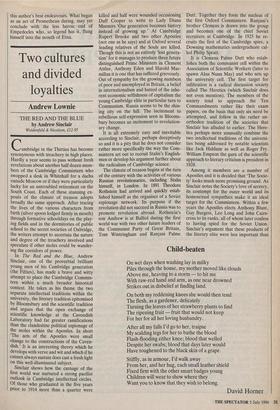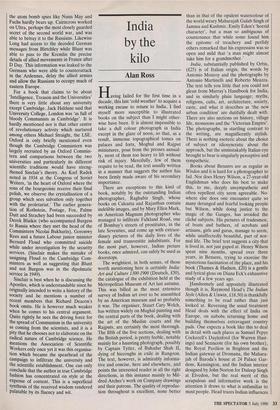Two cultures and divided loyalties
Andrew Lownie
THE RED AND THE BLUE by Andrew Sinclair
Weidenfeld & Nicolson, £12.95
Cambridge in the Thirties has become synonymous with treachery in high places. Hardly a year seems to pass without fresh revelations about another half dozen mem- bers of the Cambridge Commintern who swopped a desk in Whitehall for a dacha outside Moscow or if they were particularly lucky for an untroubled retirement on the South Coast. Each of these stunning ex- posés of the climate of treason adopts broadly the same approach. After tracing the lives of the various characters from birth (silver spoon lodged firmly in mouth) through formative schooldays on the play- ing fields and in the dormitories of public school to the secret societies of Oxbridge, the writers attempt to ascertain the nature and degree of the treachery involved and speculate if other moles could be wander- ing the corridors of power.
In The Red and the Blue, Andrew Sinclair, one of the proverbial brilliant young men of his Cambridge generation (the Fifties), has made a brave and witty attempt to place the Cambridge Commin- tern within a much broader historical context. He takes as his theme the two separate intellectual traditions within the university, the literary tradition epitomised by Bloomsbury and the scientific tradition and argues that the open exchange of scientific knowledge at the Cavendish Laboratory had far greater ramifications than the clandestine political espionage of the moles within the Apostles. In short `The acts of the Apostles were small change to the constructions of the Caven- dish.' It is an interesting theory which he develops with verve and wit and which if he cannot always sustain does cast a fresh light on this well-illuminated subject. Sinclair shows how the carnage of the first world war nurtured a strong pacifist outlook in Cambridge intellectual circles. Of those who graduated in the five years prior to 1914 more than a quarter were killed and half were wounded occasioning Duff Cooper to write to Lady Diana Manners 'Our generation becomes history instead of growing up.' At Cambridge Rupert Brooke and two other Apostles (not one as he says) and at Oxford several leading relatives of the Souls are killed. Though this is not an entirely 'lost genera- tion' for it manages to produce three future distinguished Prime Ministers in Clement Attlee, Anthony Eden and Harold Mac- millan it is one that has suffered grievously. Out of sympathy for the growing numbers of poor and unemployed in Britain, a belief in internationalism and hatred of the inhe- rent economic selfishness of capitalism the young Cambridge elite in particular turn to Communism. Russia seems to be the shin- ing city on the hill. The incitement to rebellious self-expression seen in Blooms- bury becomes an incitement to revolution- ary change. It is all extremely easy and inevitable according to Sinclair, perhaps deceptively so and it is a pity that he does not consider rather more specifically the way the Com- mintern set out to recruit Stalin's English- men or develop his argument further about the radicalism of Cambridge science.
The climate of treason begins at the turn of the century with the activities of various Russian revolutionaries, including Stalin himself, in London. In 1891 Theodore Rothstein had arrived and quickly estab- lished himself as the organiser of a Soviet espionage network. Its purpose if the revolution did not succeed in Russia was to promote revolution abroad. Rothstein's son Andrew is at Balliol during the first world war with two other future leaders of the Communist Party of Great Britain, Tom Wintringham and Ranjani Palme Dutt. Together they form the nucleus of the first Oxford Commintern. Ranjani's brother Clemens is drawn into the group and becomes one of the chief Soviet recruiters at Cambridge. In 1925 he re- cruits the first of the Cambridge spies, a Downing mathematics undergraduate cal- led Philip Spratt.
It is Clemens Palme Dutt who estab- lishes both the communist cell within the Association of Scientific Workers (later to spawn Alan Nunn May) and who sets up the university cell. The first target for infiltration is a radical discussion society called The Heretics (which Sinclair does not even mention). The members of the society tend to approach the Ten Commandments rather like their exam papers, on the basis that only six need be attempted, and follow in the rather un- orthodox tradition of the societies that Sinclair has alluded to earlier. The Here- tics perhaps more unusually combine the two intellectual traditions of the universi- ties being addressed by notable scientists like Jack Haldane as well as Roger Fry. William Empson the guru of the scientific approach to literary criticism is president in 1928.
Among it members are a number of Apostles and it is decided that 'The Socie- ty' looks much more promising ground. As Sinclair notes the Society's love of secrecy, its contempt for the outer world and its homosexual sympathies make it an ideal target for the Commintern. Within a few years the Apostles elects Anthony Blunt, Guy Burgess, Leo Long and John Cairn- cross to its ranks, all of whom later confess to having spied for the Soviet Union. Sinclair's argument that these products of the literary elite were less important than the atom bomb spies like Nunn May and Fuchs hardly bears up. Cairncross worked on Ultra, perhaps the most closely guarded secret of the second world war, and was able to betray it to the Russians. Likewise Long had access to the decoded German messages from Bletchley while Blunt was able to pass to the Kremlin the precise details of allied movements in France after D Day. This information was leaked to the Germans who were able to counterattack in the Ardennes, delay the allied armies and allow the Russians to occupy much of eastern Europe.
For a book . that claims to be about `Intelligence, Treason and the Universities' there is very little about any university except Cambridge. Jack Haldane said that University College, London was 'as full of bloody Communists as Cambridge'. It is hardly mentioned nor is that other centre of revolutionary activity which nurtured among others Michael Straight, the LSE. Oxford is only briefly mentioned even though the Cambridge Commintern was largely recruited by an Oxford Commin- tern and comparisons between the two universities and particularly its different scientific traditions would have streng- thened Sinclair's theory. As Karl Radek noted in 1934 at the Congress of Soviet Writers, 'in the heart of Oxford where the sons of the bourgeoisie receive their final polish, we observe the crystallisation of a group which sees salvation only together with the proletariat.' The earlier genera- tion of Rothstein, Postage, Fox, Palme Dutt and Strachey had been succeeded by Derek Blaikie (who accompanied Burgess to Russia where they met the head of the Commintern Nicolai Bukharin), Goronwy Rees and a future Labour junior minister Bernard Floud who committed suicide while under investigation by the security services. (Sinclair makes the mistake of assigning Floud to the Cambridge Com- mintern as well as suggesting that Blunt and not Burgess was in the dipolmatic service in 1949).
Sinclair is best when he is discussing the Apostles, which is understandable since he originally intended to write a history of the society and he mentions a number of recent members that Richard Deacon's book omits. He is however much weaker when he comes to his central argument. Quite rightly he sees the driving force for the spread of Communism in the university as coming from the scientists, and it is a pity that he chooses not to elaborate on the radical nature of Cambridge science. He mentions the Association of Scientific Workers only once yet it was this organisa- tion which became the spearhead of the campaign to infiltrate the university and the scientific establishment. One can only conclude that the author in true Cambridge fashion has concentrated on style at the expense of content. This is a superficial synthesis of the received wisdom rendered palatable by its fluency and wit.



















































 Previous page
Previous page